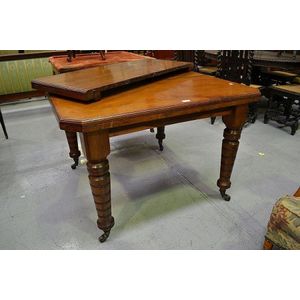Georgian Pembroke Table with Turned Legs and Casters
Georgian pembroke table, with drawer to one end, drawer front to the other, on turned legs with metal casters, 100.5 cm wide, 72.5 cm high,
You must be a subscriber, and be logged in to view price and dealer details.
Subscribe Now to view actual auction price for this item
When you subscribe, you have the option of setting the currency in which to display prices to $Au, $US, $NZ or Stg.
This item has been sold, and the description, image and price are for reference purposes only.
- Turning - Any part of a piece of furniture that has been turned and shaped with chisels on a lathe. Turned sections include legs, columns, feet, finials, pedestals, stretchers, spindles etc. There have been many varieties and fashions over the centuries: baluster, melon, barley-sugar, bobbin, cotton-reel, rope-twist, and so on. Split turning implies a turned section that has been cut in half lengthwise and applied to a cabinet front as a false decorative support.
- Georgian - As an English stylistic period, Georgian is usually taken to cover the period from George I (1714) to the Regency of Prince George (1811-20), although the period from 1800 to 1830 is sometimes designated as the Regency period. During the Georgian period the great English cabinetmakers and designers such as Chippendale, Hepplewhite, Adam Sheraton etc., were all active.
Therefore there isn't a single 'Georgian style' as such and to say something is 'Georgian', usually means it was made between 1714 and 1830. This assumes we discount George V and George VI, both being from the 20th century.
The styles popular at the time of each reign were:
George I (1714-1727) saw out the last years of the Baroque period.
George II (1727-1760) reigned during the Rococo period.
George III (1760-1820) saw the last gasp of the Rococo, all of the early Neo-Classic 'Adam style' and most of the later neo-Classic 'Regency style'.
George IV (Prince Regent 1820-1830)encompassed the last of the 'Regency' style.
William IV's reign (1830-1837) was something of a no man's land (stylistically) and he wasn't a 'George' anyway. He covered the last glimmerings of 'Regency' and the start of the 'Victorian' style. - Turned Legs - are legs which have been turned on a lathe. In use from the 16th century, turned legs on tables, chairs and cabinets became more frequent until, by the 1830s, the Georgian square or tapered leg was rarely found except in country pieces.
This item has been included into following indexes:
Visually similar items

Victorian cedar Pembroke table, with drawer to one end, 126 cm long, 71 cm high
Sold by
in
for
You can display prices in $Au, $US, $NZ or Stg.

Early Victorian Brazilian rosewood tea table, with fold over top, drawer and faceted turned legs, 105 cm wide, 72 cm high
Sold by
in
for
You can display prices in $Au, $US, $NZ or Stg.

Antique walnut turned leg extension dining with one leaf table, 146 cm extended x 104 cm wide
Sold by
in
for
You can display prices in $Au, $US, $NZ or Stg.

French style ladies writing desk, inlaid decoration, approx 82 cm high, 120 cm wide, 60 cm deep
Sold by
in
for
You can display prices in $Au, $US, $NZ or Stg.
